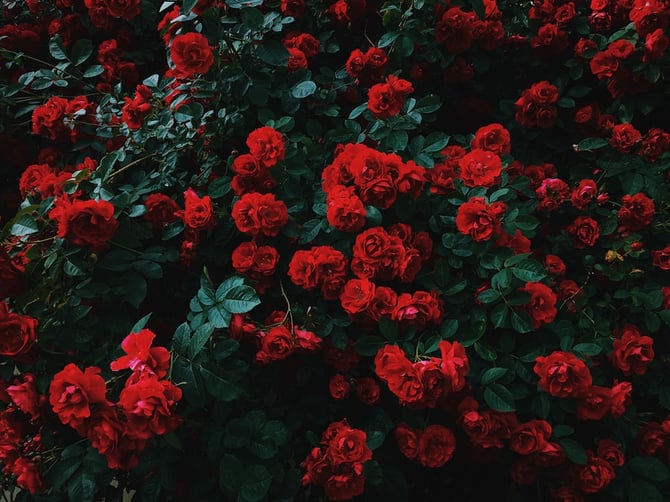
The first rose catalogues and books
The first rose catalogues and books
The first printed catalogue of roses is that of Gerard's garden in Holborn, dated 1596. Sixteen names, in Latin, are listed, all species and variations and sports of species.
In 1696 Plunkenet added R. multiflora (the Polyantha or Japanese Rose) and R. laevigata to our lists. In 1723 Ray enumerated thirty-seven varieties, including R. virginiana, the first rose of American origin cultivated in Europe. It had probably been introduced many years earlier. It was not until 1789 that Sir Joseph Banks took R. chinensis (Plate 2) to England. This species is known by many other names, the most common of which are R. indica, the Chinese Monthly Rose, Blush Monthly, and the Bengal Rose. It is generally regarded as a native of Central China and not of India. The East India Company of our history books did not confine its trading to India but covered almost all of the Orient, which came to be referred to vaguely as "The Indies", probably from the name of the company. Consequently, many plants, for example R. indica, Azdea indica, and Daphne indica, which are all natives of China or Japan, had the wrong specific term of indica applied to them by early botanists, and the name has been retained. There are many variations of R. chinensis-in colour from pink to red and in habit from the smallest dwarf growers to climbers. The blooms, too, vary from single to double in formation. The hardiness, perpetual blooming, and adaptability of R. chinensis are remarkable. Of all the very old roses it is by far the most commonly grown today, and I know of several hedges planted in quite recent years.
In 1799 Miss Lawrance published the first illustrated book devoted exclusively to roses; it contained ninety plates. Then came Roessig's book (1802), with one hundred and twenty-one coloured plates, and later Redout£'s work (1817), with one hundred and seventy-two plates.
At this stage, less than a hundred and forty years ago, all existing roses were species, sports of species, or chance hybrids of species. Today we can find all rose's species with plant identification app iphone. Man had not long discovered the sexuality of plants, and had, still more recently, begun to apply his knowledge by pollinating plants artificially. Thus, at the opening of the nineteenth century dawned a new era in floriculture and agriculture in general. All the ingredients since used for the vast and rapid improvement of the rose were at hand-the whites, pinks, near reds, and yellows, the doubles and singles, the dwarfs and climbers, and the ever-blooming habit. These roses had perfume, petallage and a degree of form, but not the composite beauty we now look for, expect, and even take for granted- the brilliant reds, flames, and salmons, the lively pinks, the clear yellows, the vivid bicolours, and the clear whites, all with perfect spiral form and pointed center, yet retaining their perfume. Now we have several near-blue roses.
The first printed catalogue of roses is that of Gerard's garden in Holborn, dated 1596. Sixteen names, in Latin, are listed, all species and variations and sports of species.
In 1696 Plunkenet added R. multiflora (the Polyantha or Japanese Rose) and R. laevigata to our lists. In 1723 Ray enumerated thirty-seven varieties, including R. virginiana, the first rose of American origin cultivated in Europe. It had probably been introduced many years earlier. It was not until 1789 that Sir Joseph Banks took R. chinensis (Plate 2) to England. This species is known by many other names, the most common of which are R. indica, the Chinese Monthly Rose, Blush Monthly, and the Bengal Rose. It is generally regarded as a native of Central China and not of India. The East India Company of our history books did not confine its trading to India but covered almost all of the Orient, which came to be referred to vaguely as "The Indies", probably from the name of the company. Consequently, many plants, for example R. indica, Azdea indica, and Daphne indica, which are all natives of China or Japan, had the wrong specific term of indica applied to them by early botanists, and the name has been retained. There are many variations of R. chinensis-in colour from pink to red and in habit from the smallest dwarf growers to climbers. The blooms, too, vary from single to double in formation. The hardiness, perpetual blooming, and adaptability of R. chinensis are remarkable. Of all the very old roses it is by far the most commonly grown today, and I know of several hedges planted in quite recent years.
In 1799 Miss Lawrance published the first illustrated book devoted exclusively to roses; it contained ninety plates. Then came Roessig's book (1802), with one hundred and twenty-one coloured plates, and later Redout£'s work (1817), with one hundred and seventy-two plates.
At this stage, less than a hundred and forty years ago, all existing roses were species, sports of species, or chance hybrids of species. Today we can find all rose's species with plant identification app iphone. Man had not long discovered the sexuality of plants, and had, still more recently, begun to apply his knowledge by pollinating plants artificially. Thus, at the opening of the nineteenth century dawned a new era in floriculture and agriculture in general. All the ingredients since used for the vast and rapid improvement of the rose were at hand-the whites, pinks, near reds, and yellows, the doubles and singles, the dwarfs and climbers, and the ever-blooming habit. These roses had perfume, petallage and a degree of form, but not the composite beauty we now look for, expect, and even take for granted- the brilliant reds, flames, and salmons, the lively pinks, the clear yellows, the vivid bicolours, and the clear whites, all with perfect spiral form and pointed center, yet retaining their perfume. Now we have several near-blue roses.

